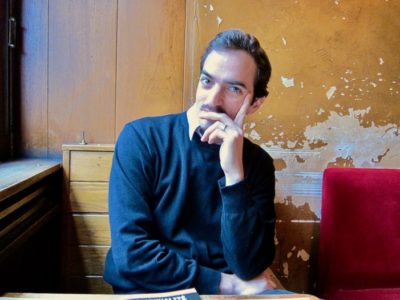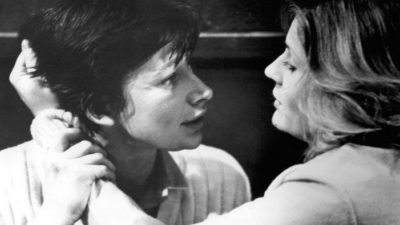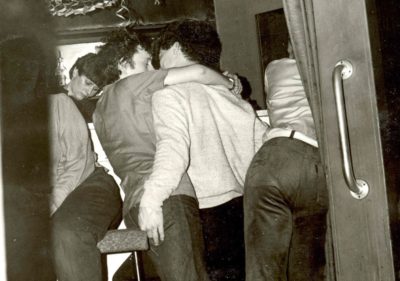
08 Feb A Queer Academic Explains How Gay Culture Survived East European Communism
Mathieu Lericq is one of the co-organizers of a particularly original conference to be held in Paris next week entitled “Communist Homosexuality 1945-1989”. It brings together researchers from all over eastern and western Europe to discuss issues related to homosexuality in the days of communism. In addition to the symposium itself (scheduled for Feb. 2 and 3 in Créteil and Paris) there’s a series of events including exhibitions, films and live performances.
The period covered in the conference concludes just before the fall of the Berlin Wall, which went up after the Second World War. Its erection divided east and west Germany and marked the establishment of communist regimes under the leadership of the U.S.S.R..
Lericq is a PhD student at the University of Aix-Marseille and devotes his research mainly to an anthropological and political analysis of film, specifically exploring the presence of “non-standard bodies” (homosexuals and other political outsiders) in the films. Following his first study abroad to Krakow, he chose to return to Poland in 2012 to live and work there.
Lericq told Unicorn Booty that he considered his experiences in Poland to be crucial experiences. His work and upcoming conference seek to question, unmaliciously, how history has brought together the concepts of “homosexuality” and “communism”, two words that have become laden with history, meaning and affect over the past decades.
Why was your stay in Poland so important for you?
This stay was a crucial moment: I not only accepted my homosexuality, but also gradually discovered a whole homosexual life that I did not suspect. This part of the history of homosexuality is relatively unknown in Western Europe. It was also, at one point, a new field of research which presented itself, and meeting with a few Polish scholars, as well as artists, gave it its legitimacy in my eyes. After a few more studies, I decided to dedicate my PhD thesis to the presence of unusual bodies, especially homosexuals, in Polish films produced before 1989.
How would you describe these “out of norms” bodies?
Under communism, the social order was theoretically blended with the State, this being particularly problematic on the basis of Stalinism, which had re-initiated a penalization of certain behaviors, including homosexual acts in the U.S.S.R., as early as 1934. After the Second World War, the dignitaries of the “people’s democracies” continued the argument to define what was politically (and therefore socially) “normal” and what was not. What was normal was the basic family. It was difficult to think otherwise of the family nucleus than the classical, heterosexual family, even if in fact the models were necessarily destabilized.
What I’m interested in is that at some point in the 1960s, and particularly after 1968, some bodies that were not included in that standard began to emerge and say that they exist, through magazines and through art. In Poland, the issue of homosexuality crystallized in the 1980s, especially at the time of “Operation Hyacinth”. An operation launched by the Polish police to list all the homosexuals of the country. Arguing it was for the prevention of AIDS that was making a lot of talk at the time. This action had actually created an effective blackmail tool used by the political police for homosexuals. Thus homosexuals, desirous of emancipation through the creation of magazines and activities properly homosexual, would remain in the shadow. Nevertheless, the 1980s were a time of transformations, not just in Warsaw.
Was there homogeneity in the countries of the former Soviet bloc concerning the laws or were some countries more gay-friendly than others?
This question is of course linked to the history of communism itself. Communism had a turning point in 1934, when Stalin decided to return to normalization of Soviet society. All the gains in terms of female emancipation, for example, are questioned at this time, just as much as sexual freedom. Nor should it be imagined that things had been turned upside down after 1917, but certain rights had been acquired and gender equality had been relatively asserted.
When in 1945 the political form of communism was applied to eastern Europe, certain questions arose, such as how to respond to the liquidation, or at least the criminalization, of certain minorities who had been stigmatized during the Second World War. Obviously, homosexuals have often continued to be persecuted, and in other cases, legislation changed gradually during the 1960s.
But if we want to map the presence and legitimacy of homosexuality in different contexts, I would say that, on a purely legal level, some countries have decriminalized sexual acts between people of the same sex earlier than others. In Hungary decriminalization was decided in 1961. East Germany decriminalized them in 1967, a year before West Germany!
And what about Poland?
Poland is a somewhat peculiar case, since in 1932 the penal code no longer evoked homosexuality. This did not mean that socially, homosexuality was perfectly accepted. This meant, nevertheless, that we did not go to prison or to the gulag, for that. In U.S.S.R. on the contrary, there were heavy sentences, up to five years’ imprisonment, on grounds of homosexuality.
Were there connections between homosexuals from the east in the days of communism?
What I find interesting is that at that time, the Eastern countries formed a bloc and, as a bloc, fruitful relations were created between the homosexual citizens of several countries. A solidarity between the marginalized sometimes allowed to counter, at least to circumvent a little, the official penalization.
There are sorts of homosexual legends which tell that Hungary and Bulgaria were places well-liked by East European homosexuals. There was an air of freedom a little more assertive in very specific places, at any rate during the holidays. In Prague, there was a well-known bar, the Tekko, identified by the authorities.
It was discovered after 1989 that there were enormous numbers of homosexuals who, under the price of blackmail, had been placed under the spy of the Czech secret police; they were going to watch what was going on there. But in Prague, gay men and lesbian women mingled, especially in private parties, which is not necessarily the case in other contexts.
During the day, sociability was mostly around the public toilets. These places were stigmatized, police raids took place regularly. One can discover aspects of these realities in the last issue of the magazine DIK Fagazine n° 11, published in bilingual English-French version especially for the conference.
In Poland, and in the socialist bloc in general, are there striking figures of homosexuality during the period 1945-1989?
Many artists have marked Polish culture with homoerotic works. I am thinking in particular of author Jerzy Andrzejewski, author of The Gates of Paradise (Bramy Raju, 1960). There is also Jarosław Iwaszkiewicz. Their books are marked by very strong borrowing from a kind of nascent gay culture and a strong sexual tension between men, which can today be called homoerotic.
When Andrzej Wajda adapted Andrzejewski’s book in 1968 to screen, he strongly invested this erotic tension. Witold Gombrowicz, author of the novel Trans-Atlantic (1957), an atypical book that tells of the relatively delusional Argentine wanderings, inscribed in this marginal life which he lived and which is devoted to homosexual practices. Recently, thanks to the publication of his diary, it was possible to verify that Gombrowicz had begun his homosexual “attempts” as early as 1934 in Poland, before living his homosexuality in Argentina and then when he returned to Europe.
I also have to mention the great performers of the period: Krzysztof Jung and Krzysztof Niemczyk. They have invested homosexual corporalities, bringing into play their nudity and physical plasticity, carried by a provocative, subtle and committed spirit.
To open up to other contexts, the figure of homosexuality in Hungary is heterosexual. It is the director Károly Makk. He was the first to make a film about love between two women in 1982: Another Way (photo above). Károly Makk was interested in the social “symptom” of homosexuality at that time. The film is adapted from a novel by Erzsébet Galgóczi.
What about Russian homosexuals under communism?
Other known homosexuals lived under the Soviet regime, such as Slava Mogutin, who in the 1990s was the first Russian homosexual to be granted asylum in the United States on grounds of homophobic persecution. He wrote the first texts on the history around the violence suffered by homosexuals in the post-war period in U.S.S.R..
I think, also of a figure of the East German cinema who accepted his homosexuality very late, having had a wife and children. He accepted his homosexuality by making a film called Coming Out which was released on Nov. 9, 1989 in East Berlin, the day of the fall of the Berlin Wall. Some say, therefore, that East Germany has never experienced its coming-out.
In contrast, for some others, the film proves that there may have been, in extremis, a genuine exploration of homosexual desire as such in the German Democratic Republic (East Germany), and not merely the mention of homosociality on a journalistic level. In my opinion, this film has something very precious. In contexts where legal and social discrimination were applied more or less violently in different contexts, cinema was one of the first places of recognition of homosexuality in Central and Eastern Europe.
Do we know if there were any relations between homosexuals in the west and east during this period?
Relations were mainly through magazines. I would like to mention here Ryszard Kisiel who created the first homosexual magazine, Filo, a magazine which was an information platform for Polish homosexuals, but also had a collection of articles from all over the world, distributed through the port city of Gdansk, where Ryszard was born and where he worked. He had access to a number of homosexual magazines from western countries.
On the other hand, magazines like Gai Pied in France were interested in the situation of homosexuals in Eastern Europe. During the 1980s, journalists like Catherine Durand traveled to Prague and Warsaw. Moreover, our conference is also a way to change the archetypes about how we lived behind the Iron Curtain in a particular historical moment where there’s a tendency to forget the importance of these LGBT cultures in the East and their influences on western Europe.
One can also think of the East-West relations at the level of cinematographic culture. For example, the presentation of the Hungarian film Another Way at the Cannes Film Festival in 1982, which won the Women’s Interpretation Award, made it possible to point out in a West European context the situation of homosexuals, and in particular of lesbian women, in the East. Nor should we forget the importance of Radio Free Europe, which often spoke of dissident and minority groups; sometimes the sexual freedoms were studied there.
Is 1989 really a turning point for homosexuals in (post) communist contexts?
Researchers are still wondering if 1989 is a caesura (i.e., a break) that corresponds to the end of something or the beginning of something else. The tendency in western Europe is to see 1989 as the beginning of democratization, whereas there are scholars like the historian Krzysztof Pomian who explains that it is the end of a battle begun much earlier. By extension, it can be said that 1989 is a turning point rather than a true call of freedom.
Moreover, it would be a little caricatural to think that in 1989 the situation of homosexuals in Western Europe was completely appeased, and that in view of the total freedom enjoyed by homosexuals in the West, homosexuals in the East would be 30 years late. This view of things must be called into question today and, on the contrary, the extent to which the problematic of homosexuality remains very problematic in Western Europe in the 1980s. Things are progressing only gradually in terms of acquired rights, in both capitalist and communist contexts.
After 1989, homosexuals could form independent organizations. That was not possible before. This was all the more apparent at the time of the integration of the East European countries into the European Union. Societal issues have been debated, sometimes violently. This was particularly harsh in Romania, a country where the criminalization of homosexuality was abolished very late.
What is complex is that the history of homosexualities can never be seen at one level: when one considers it only at a political level or at a legal level, or at an artistic and cultural level, one misses a little the complexity of the presence and value of homosexuality. In some contexts, the cultural level may call into question the legal level. In some other contexts, the legal level may, on the contrary, call into question the political level. One of the stakes of the conference is to correlate these different levels of questioning. This also leads us to consider the complexity encompassed by the very notion of homosexuality, that it be defined as desire, as sociability and even as emerging identity.
Finally, I would say that if 1989 has really changed things, it is in the awareness of AIDS. Before that date, it was even forbidden in some contexts to produce or use condoms. That seems absurd today. On this point, there is considerable progress. On the other hand, homophobia is returning to the political sphere, and this should not have consequences for the social and medical management of AIDS.
How was your project initiated?
This conference was born of my meeting with Jérôme Bazin, lecturer at the University Paris-Est Créteil, a few years ago during a colloquium in Berlin. We give the Paris conference the title of “Communist Homosexuality,” which may seem a little astonishing, even disturbing, but which for us, beyond its polemical character, seemed very stimulating.
Why did you organize this conference in Paris?
As French researchers, it seemed interesting to integrate our questions to the French context. This echoes a certain form of difficulty, if not skepticism, for research in France to address in a calm way the question of sexuality in general and that of homosexuality in particular. There is always a fear of the French academic environment today that, basically, to think about homosexuality would be to minimize everything to the question of gender. The latter remains as problematic in French society as in the academic world, whatever may be said of it.
Scientific culture centered on homosexuality must become central again, supported by homosexuals and heterosexuals alike. I would like to see this field of research become as important as when André Baudry, Roger Peyrefitte and Jean Cocteau founded the magazine Arcadie in 1954. The social value of homosexuality was at the time a highly invested field of research.
We must make the sad conclusion that apart from a very valuable journalistic contribution from gay magazines and a few books (especially those by Florence Tamagne and Éric Fassin), French research has been shy about European homosexuality as a whole. To make this colloquy in Paris means therefore to wish that Paris and the French academic milieu reclaims its pioneering role in the reflections on European homosexualities.
Is your approach a form of activism?
No, it’s not militancy. It’s about finding a link with a lost story. From my point of view, it is necessary to put the cursor on the symptoms of our actuality, and one of these symptoms is the ignorance towards the homosexual populations of the East-European contexts. However, as Michel Foucault demanded, research must be the analysis of “today”. When we look at researchers who deal with homosexuality today in France, in all disciplines, and despite the existence of a few departments and institutions focused on sexual matters, scientific interest in these matters is very sporadic, too disjointed.
The idea underlying the organization of this conference in Paris is also the idea of inviting all these researchers to come together and work together. Thus, even if the approach is not militant, it could help to focus interest on this relatively disparaged field of research, and thus give political value to the exchanges that the conference will generate.







